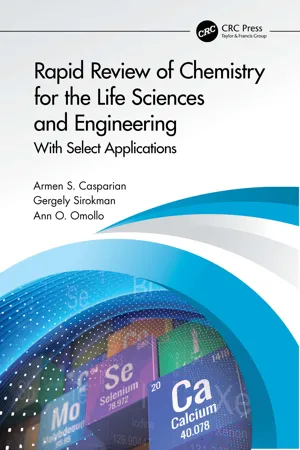
Rapid Review of Chemistry for the Life Sciences and Engineering
With Select Applications
- 275 pages
- English
- ePUB (mobile friendly)
- Available on iOS & Android
Rapid Review of Chemistry for the Life Sciences and Engineering
With Select Applications
About This Book
Designed to demystify chemistry for the non-chemist, Rapid Review of Chemistry for the Life Sciences and Engineering is a useful reference manual for life scientists and engineers, who may have forgotten a formula, principle, or concept in the college chemistry taken a few years ago.
With over 100 solved examples, from balancing chemical reactions, doing stoichiometry, and understanding nomenclature rules in both organic and inorganic chemistry, to calculating half-lives in kinetics or radioactive decay schemes, understanding colligative properties of solutions, and interpreting toxicities of hazardous materials, this book is intended to make reviewing and understanding chemistry much clearer and easier. Relevant diagrams are in color and solved examples are organized by subject/topic and cross-referenced by page and chapter number.
It may also serve as a concise go-to sidekick for students, who are not chemistry majors, taking chemistry at the college level and having difficulty understanding the scope, focus, language, or equations in their chemistry textbook.
Armed with select, contemporary applications, it is written in the hope to bridge a gap between chemists and non-chemists, so that they may communicate with and understand each other. Chapters 1-10 are designed to contain the standard material in an introductory college chemistry course. Chapters 11-15 present applications of chemistry that should interest and appeal to scientists and engineers engaged in a variety of fields.
Additional features
- More than 100 solved examples clearly illustrated and explained with SI units and conversion to other units using conversion tables included
- Assists the reader to understand organic and inorganic compounds along with their structures, including isomers, enantiomers, and congeners of organic compounds
- Provides a quick and easy access to basic chemical concepts and specific examples of solved problems
- Ideal sidekick for students who are non-chemistry majors taking intro. college chemistry, needing clear, concise explanations
This concise, user-friendly review of general and organic chemistry with environmental applications will be of interest to all disciplines and backgrounds.
Frequently asked questions
Information
1 Introduction
1.1 The Basics of Matter
- Bubbling or fizzing, indicating the release of a gas
- Color change
- Temperature change (heat released or absorbed)
- Formation of a precipitate
- Emission of light (chemiluminescence) or sound
- Rusting of iron or corrosion of any metal
- Generation of a current by a battery
- Combustion of fuel to produce energy
- Neutralization of excess stomach acid by an antacid
- Hardening of concrete
Table of contents
- Cover
- Half Title
- Title Page
- Copyright Page
- Dedication
- Table of Contents
- Foreword
- Preface
- Authors
- List of Solved Examples
- Chapter 1 Introduction
- Chapter 2 Simple Categories of Inorganic Chemical Reactions
- Chapter 3 Acids, Bases, and Salts
- Chapter 4 Chemical Equilibrium
- Chapter 5 Chemical Thermodynamics and Thermochemistry
- Chapter 6 Chemical Kinetics
- Chapter 7 Electrochemistry and RED-OX Reactions
- Chapter 8 Organic Chemistry: Naming, Structure, and Isomerism
- Chapter 9 Asymmetric Centers, Functional Groups, and Characterization
- Chapter 10 The Essentials of Polymer Chemistry
- Chapter 11 Radioactivity and Nuclear Chemistry
- Chapter 12 The Atmosphere and the Chemistry of Air
- Chapter 13 Water Quality and Water Pollution
- Chapter 14 The Chemistry of Hazardous Materials
- Chapter 15 Introduction to Basic Toxicology
- Appendix A
- Appendix B
- Appendix C
- Appendix D
- Appendix E
- Bibliography
- Index